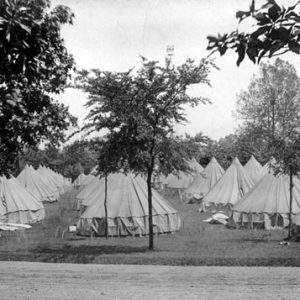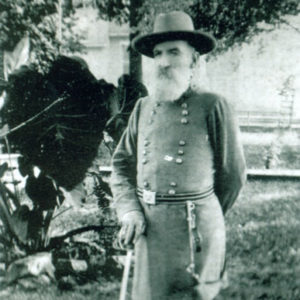calsfoundation@cals.org
Robert Glenn Shaver (1831–1915)
Robert Glenn Shaver was a former Confederate officer who raised Arkansas troops for the war, a commander who was wounded in battle, and a former outlaw who once fled the United States to escape punishment.
Robert Shaver was born on April 18, 1831, in Sullivan County, Tennessee, exactly on the line between Virginia and Tennessee. He was the third of four children born to David and Martha (May) Shaver. He attended school at home, and from 1846 to 1850, he attended Emory and Henry College in Virginia. Shaver and his parents moved to Arkansas in 1850, settling east of Batesville (Independence County) in Lawrence County (now Sharp County).
On June 10, 1856, Shaver married Adelaide Louise Ringgold. Before she died in 1889, Adelaide bore eight children. In 1859, Shaver was licensed to practice law in Lawrence County, and they resided on their farm near the White River.
With the eruption of the Civil War in 1861 and Arkansas’s secession from the Union, Shaver received an order from the Military Board of Arkansas to raise a regiment of volunteers from the White River valley. Ten counties were allotted to him from which to raise the regiment, and the organization took place at Smithville (Lawrence County) on June 16, 1861. In response to the call for soldiers, enough volunteers arrived to create thirty-two companies. Shaver was forced to send many away, as he was authorized only to organize ten companies of 120 men each into the Seventh Arkansas Regiment. Shaver was chosen as colonel, and the regiment became known as “Shaver’s Regiment” and carried that name throughout the war. Shaver and his troops were immediately ordered to Pullman’s Ferry to take a steamboat first to Columbus, Kentucky, and then to Bowling Green to engage Union forces.
Shaver’s Regiment was prominent and illustrious in the war as Shaver led them in battle in Arkansas, Kentucky, Tennessee, Alabama, Mississippi, and Texas. His troops bestowed the nickname of “Fighting Bob” on their commander. Shaver is mentioned in twelve different volumes and on several pages of the Official Records of the Union and Confederate armies.
Shaver and his Arkansas troops were part of the Confederate effort to stop the southward advance by General Ulysses S. Grant in the spring of 1862. Shaver was commander of the First Brigade of Hindman’s Division, Third Army Corps, which was composed of the Second, Sixth, and Seventh Arkansas Infantry and the Third Confederate Infantry, of which two-thirds were also Arkansas troops. Confederate General Albert Sydney Johnston engaged Grant’s forces at Shiloh, Tennessee, in April 1862. Shaver initiated the fight on the Confederate right early Sunday morning of April 6. This opening phase of the battle became known as “The Hornet’s Nest,” and Shaver was seriously wounded in the head and in his left side by an exploding shell. He was unconscious for several hours and suffered from these wounds until the end of his life.
After the Union victory at Shiloh, Shaver was eventually transferred to the Trans-Mississippi Department. In September 1862, Shaver organized the Thirty-eighth Arkansas Infantry at Jacksonport (Jackson County) and was elected colonel. He was on the field at Prairie Grove, Jenkins’ Ferry, Poison Spring, Marks’ Mills, and the Red River Campaign. He covered the Confederate retreat from Little Rock (Pulaski County) in 1863, reportedly furious that General Sterling Price would not allow him to engage the enemy.
In 1864, General Kirby Smith consolidated the Thirty-eighth Arkansas Infantry and Twenty-seventh Arkansas Infantry, and Shaver commanded these two regiments, known until the end of the war as “Shaver’s Infantry Regiment.”
In March 1865, Shaver received orders to report to Texas and to take command of the port at Galveston. He got as far as Marshall, Texas, when word was received of Lee’s surrender to Grant in Virginia. When he received notice the war was over, he took his command to Shreveport, Louisiana, and surrendered to General Francis Herron. Shaver’s surrender was the last organized Confederate force to surrender in the war.
Shaver procured a large steamboat to transport his men to Jacksonport (most of his troops were from northern Arkansas) from General Herron. He arrived at Jacksonport on June 20, 1865, and his men were disbanded.
Shaver’s activities with the Arkansas Ku Klux Klan after the war eventually caused serious legal problems. Most modern state historians now scoff at Shaver’s claim that he was the Klan commander in Arkansas with 10,000 Klansmen in opposition to the Powell Clayton carpetbagger regime. Although his claims may not stand close modern scrutiny, by 1868 state carpetbagger leaders had him charged with murder, arson, treason, and robbery. When General Daniel Phillips Upham and the state militia were sent to arrest him, he quickly fled the state to New Orleans, Louisiana. His family later joined him there, and they all boarded the British steamboat Mexico for British Honduras.
By 1872, Shaver returned to Arkansas upon hearing that his personal friend Elisha Baxter had replaced Clayton as governor. The records are probably lost, and the details may never be known, but within twenty-four hours, all charges and indictments against him were dropped. He had breakfast with Powell Clayton and then left for Jacksonport.
Shortly after returning to Jacksonport in 1872, he was informed that Governor Baxter had appointed him to the position of sheriff for newly created Howard County in western Arkansas. Shaver lived in Center Point (Howard County) until 1899, practicing law after leaving his duties as sheriff. In 1899, he and his family moved to Mena (Polk County) to live with his son. In the 1890s, Shaver was made commander of the State Guard and the Reserve Militia of Arkansas and received the rank of general. He was also the commander of the Arkansas Division of the United Confederate Veterans (UCV).
While in Mena, many newspapers interviewed him and wrote feature articles concerning his experiences. Shaver’s many stories appeared in the Mena Evening Star, the Polk County Democrat, the Mena Weekly Star, the Memphis Commercial Appeal, and several magazines. The Commercial Appeal sent Robert Brown to Mena in June 1909 to interview Shaver about his past ties with the Ku Klux Klan. This interview was published in the Commercial Appeal to coincide with the United Confederate Veterans reunion being held in Memphis.
In 1910, he was selected to raise funds and to dedicate a monument and choose its location on the Shiloh battlefield to honor all the Arkansas soldiers who fought and died there. On September 26, 1911, Shaver gave the main address at the dedication of the memorials on the former battleground at Shiloh. When Little Rock was chosen as the site for the annual reunion of the Confederate Veterans, he was made commander-in-charge of the camp, and the National Encampment of the United Confederate was known as “Camp Shaver.”
By 1914, Shaver was becoming feeble and traveled to Foreman (Little River County) to be with his two daughters. He died at Foreman on January 13, 1915, and was buried in his Confederate uniform at Center Point Cemetery in Howard County.
For additional information:
Bowers, Rodney. “Descendants Honor Klansman, War Hero.” Arkansas Democrat-Gazette, August 28, 1995, p. 1B.
Brown, Robert J. “Gen. R.G. Shaver Led Ku-Klux-Klan.” Mena Evening Star, June 26, 1909, p. 2A.
Cooger, Harold. “General Robert G. Shaver: One of Arkansas’ Most Gallant Soldiers in the Confederate Cause.” The Looking Glass 16 (June 1990): 8-12.
Evans, Clement A. Confederate Military History, Louisiana and Arkansas. Vol. 10. Secaucus, NJ: The Blue and Grey Press, n.d.
“Gen. R. G. Shaver Has Answered Last Roll Call.” Mena Evening Star, January 14, 1915, p. 1A.
“Gen. Robert G. Shaver.” Mena Weekly Star, May 30, 1907, p. 7A.
The Goodspeed Biographical and Historical Memoirs of Southern Arkansas. Easley, SC: Southern Historical Press, 1978.
Powell, Wilson. “‘Fighting Bob’ Shaver.” Independence County Chronicle 3 (October 1961): 38–44.
“Soon to Unveil Shiloh Monument.” Polk County Democrat, September 21, 1911, p. 4A.
Harold Coogan
Mena, Arkansas
This entry, originally published in Arkansas Biography: A Collection of Notable Lives, appears in the CALS Encyclopedia of Arkansas in an altered form. Arkansas Biography is available from the University of Arkansas Press.
 Civil War through Reconstruction, 1861 through 1874
Civil War through Reconstruction, 1861 through 1874 Military
Military Camp Shaver
Camp Shaver  Robert Shaver
Robert Shaver  UCV Reunion
UCV Reunion 




Comments
No comments on this entry yet.